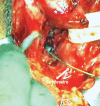The use of suprapubic cystoscopy in perineal urethroplasty
- PMID: 26328118
- PMCID: PMC4548608
- DOI: 10.5152/tud.2013.061
The use of suprapubic cystoscopy in perineal urethroplasty
Abstract
Objective: Posterior urethral strictures are difficult cases to treat for urologists. Anastomotic open urethroplasty is the major surgical treatment option, and various modifications/manipulations to the procedure have been recommended in the literature. We aimed to assess the advantages of performing antegrade endoscopy through the suprapubic cystostomy tract during perineal urethroplasty.
Material and methods: Thirty-six perineal urethroplasties combined with suprapubic cystoscopy were performed in 33 adult male patients between 2005 and 2011. Pre-and peri-operative records of the patients were evaluated, with a particular focus on suprapubic cystoscopy findings during urethroplasty.
Results: The mean patient age was 41 years, and the mean lesion length was 2.6 cm (range 1-10 cm). Lesions were secondary to pelvic trauma in 21 patients, to a history of prostatic surgery in 8 patients, and to other miscellaneous causes in the 4 remaining patients. In 23 cases with normal bladder necks, the anastomosis was created under the guidance of antegrade cystoscopy with fluoroscopy. In 10 cases, stiff guide wires or paddles were used in addition to endoscopic light to identify the correct anastomosis site. In two procedures, fistula openings were identified during endoscopy, and fistula repair was performed along with anastomosis. In one case involving the longest lesion with involvement of the bladder neck, a combined perineal-transpubic urethroplasty was performed. The mean follow up duration was 19 (3-38) months. The overall success rate was 91%, and the re-operation rate was 9%.
Conclusion: Suprapubic cystoscopy is an easy-to-perform adjunctive modality in perineal urethroplasty. This method provides the benefits of supplementary endoscopic findings and feasibility of certain maneuvers that facilitate debridement and anastomosis formation concurrent with perineal urethroplasty.
Keywords: Anastomosis; cystoscopy; perineum; suprapubic; urethral stricture.
Figures
Similar articles
-
Delayed surgical repair of posttraumatic posterior urethral distraction defects in children and adolescents: long-term results.J Pediatr Urol. 2015 Apr;11(2):67.e1-6. doi: 10.1016/j.jpurol.2014.09.010. Epub 2015 Feb 20. J Pediatr Urol. 2015. PMID: 25869826
-
Perineal anastomotic urethroplasty in a pediatric cohort with posterior urethral strictures: critical analysis of outcomes in a contemporary series.Urology. 2014 May;83(5):1145-8. doi: 10.1016/j.urology.2013.11.028. Epub 2014 Jan 31. Urology. 2014. PMID: 24485997
-
Factors contributing to a successful outcome of combined abdominal transpubic perineal urethroplasty for complex posterior urethral disruptions.J Urol. 2006 Dec;176(6 Pt 1):2514-7; discussion 2517. doi: 10.1016/j.juro.2006.08.016. J Urol. 2006. PMID: 17085145
-
Traumatic Posterior Urethral Strictures in Children and Adolescents.Front Pediatr. 2019 Feb 19;7:24. doi: 10.3389/fped.2019.00024. eCollection 2019. Front Pediatr. 2019. PMID: 30838189 Free PMC article. Review.
-
Post-traumatic posterior urethral strictures: preoperative decision making.Urology. 2004 Aug;64(2):228-31. doi: 10.1016/j.urology.2004.03.019. Urology. 2004. PMID: 15302466 Review.
Cited by
-
[Diagnostic workup of urethral strictures].Urologe A. 2018 Jan;57(1):6-10. doi: 10.1007/s00120-017-0547-5. Urologe A. 2018. PMID: 29189873 Review. German.
References
-
- Koraitim MM. The lessons of 145 post-traumatic posterior urethral strictures treated in 17 years. J Urol. 1995;153:63–6. - PubMed
-
- Mundy AR. Urethroplasty for posterior urethral strictures. Br J Urol. 1996;78:243–7. - PubMed
-
- Turner Warwick R. Principles of urethral reconstruction. In: Webster G, Kirby R, King L, Goldwasser B, editors. Reconstructive urology. Blackwell Cambridge, Massachusetts; 1993. pp. 609–42.
-
- Turner Warwick R. Prevention of complications resulting from pelvic fracture urethral injuries-and from their surgical management. Urol Clin North Am. 1989;16:335–8. - PubMed
-
- Andrich DE, Dunglison N, Greenwell T J, Mundy AR. The long-term results of urethroplasty. J Urol. 2003;170:90–2. - PubMed
LinkOut - more resources
Full Text Sources
Other Literature Sources


